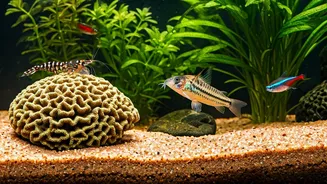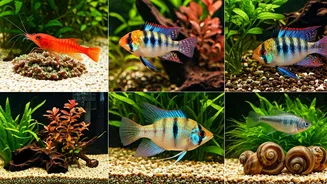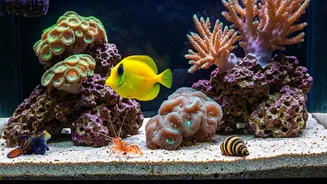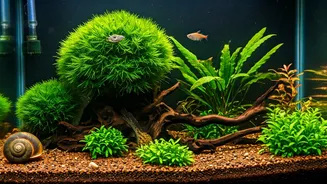Algae-Eating Snails
Snails are highly effective in controlling algae growth, a common problem in aquariums. These industrious invertebrates diligently graze on algae, preventing
its buildup on glass, decorations, and plants. Several snail species excel in this role, including Nerite snails, known for their ability to consume various algae types, and Mystery snails, which are also effective but may occasionally nibble on live plants if algae is scarce. Their constant grazing not only keeps the tank clean but also helps maintain water quality by reducing organic waste that fuels algae growth. When selecting snails, consider the size of your aquarium and the specific algae types present. Introducing a few snails can significantly reduce the need for manual cleaning and chemical treatments, fostering a more natural and balanced ecosystem. The use of algae-eating snails provides a sustainable and eco-friendly method for maintaining a cleaner, healthier aquarium environment, with the added benefit of their engaging behaviors and aesthetic appeal.
The Otto Catfish
Otto catfish, or *Otocinclus*, are small, peaceful fish that specialize in eating algae. These tiny catfish are perfect for smaller aquariums due to their modest size. They are active during the day, constantly searching for algae on plants, decorations, and the aquarium glass. Otto catfish are particularly effective at consuming diatoms and other types of algae. Keeping a small group of them ensures that they can keep up with algae growth without disrupting the aquarium’s balance. They're best kept in a well-established tank with plenty of hiding places and gentle filtration. Otto catfish's presence not only enhances the aquarium's appearance by removing unsightly algae, but also enriches the environment by preventing excessive waste buildup. They often work together, cleaning surfaces that larger fish may miss. This natural approach to algae control reduces the need for chemicals and excessive manual cleaning, making the aquarium’s maintenance easier and the aquatic environment healthier.
Shrimp Cleaners
Certain shrimp species, like the Amano shrimp and the Red Cherry shrimp, are excellent cleaners, consuming algae and detritus. Amano shrimp are recognized for their voracious appetite and ability to tackle various algae types, while Red Cherry shrimp are effective algae eaters and add vibrant color to the aquarium. These small crustaceans are constantly foraging, keeping the substrate and decorations clear of uneaten food and organic waste. Their scavenging behavior plays an essential role in the nitrogen cycle, breaking down waste and converting it into less harmful substances. They also feed on biofilm, a thin film of organic matter that can accumulate on surfaces. Their continuous activity supports a cleaner environment and healthier water quality. Shrimp are generally easy to care for and do well in planted aquariums with ample hiding places. Introducing shrimp into the aquarium provides an effective and natural method for maintaining a clean and well-balanced ecosystem, minimizing the need for extensive cleaning and chemical treatments.
Scavenging Snails
Beyond algae control, some snails act as scavengers, consuming uneaten food and decaying organic matter in aquariums. These snails, such as Malaysian trumpet snails and ramshorn snails, help keep the substrate clean and prevent the buildup of harmful waste. Malaysian trumpet snails burrow in the substrate, aerating it and preventing the formation of anaerobic pockets. Ramshorn snails are effective at eating leftover food and dead plant matter, contributing to a cleaner tank. These scavenging snails play a crucial role in the aquarium's ecosystem by breaking down organic waste, which can lead to poor water quality. Their activity reduces the buildup of harmful substances like ammonia and nitrites, promoting a healthier environment for the fish. The presence of scavenging snails reduces the need for frequent gravel vacuuming and supports the overall cleanliness of the tank. They contribute to a more balanced and sustainable ecosystem within the aquarium environment.
Detritus-Eating Worms
Detritus-eating worms, particularly various species of Tubifex worms, serve as natural recyclers in aquariums by consuming decaying organic matter and waste. These worms live in the substrate and filter through detritus, consuming it and helping to prevent its buildup. They contribute to a healthier environment by breaking down waste and converting it into less harmful substances, which can help in reducing ammonia and nitrite levels. Although some might find worms unsightly, they play a crucial role in maintaining a balanced ecosystem within the aquarium. They aerate the substrate as they move through it, improving oxygen levels for beneficial bacteria and the roots of aquatic plants. These worms are often introduced to help with the biological filtration process. The presence of detritus-eating worms contributes to a cleaner aquarium by managing organic waste. While they may not be the most visually appealing, they are essential to a naturally balanced and healthy aquatic environment.






